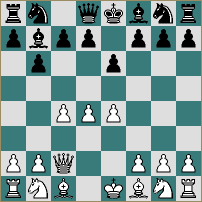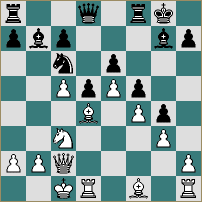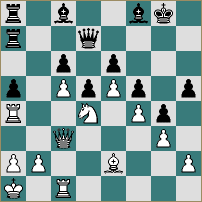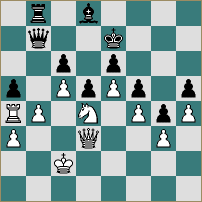Yet another one that got away
(Notes adapted from those appearing in Chess Monthly)
This game was played at the traditional Goodricke Open in Calcutta which was as strong as ever in 1998, boasting fourteen GMs and nine IMs. It is the leading open tournament in Asia. Sponsors of the England team, Duncan Lawrie, have also been wonderful enough to send a selection of British Grandmasters to India almost every year of this last decade. The Brits get especially good treatment in Calcutta (typically a chauffeur and a butler are supplied to make life a tad more bearable in the spacious Goodricke penthouse apartment). I guess it is something to do with the fact that Goodricke (a tea company) is a subsidiary of Duncan Lawrie...
The event is splendidly organised and generates enormous publicity in India. People are unusually friendly and the players are always greeted with a smile as they arrive to do battle. The playing hall is, most of the time at any rate, a den of peace and tranquillity in the midst of the crowded city.
At the start of round four, two British citizens found their way into the cool air-conditioned venue (cutting such a savage contrast with the hot, polluted air on the busy street outside), sat down opposite one another and began to play chess. One was an experienced grandmaster, the other was playing in his first proper open tournament in ten years. This is what happened...
Jon Levitt (2425) vs Nigel Short (2660)
English Defence, Calcutta, 1998
1.d4 e6
2.c4 b6
3.e4 Bb7
4.Qc2
 4... g6?!
4... g6?!
A strange choice which I suspect was the result of a little psychology. Consider:
1) The system with 1...b6 has been popular of late with several leading English players including Jon Speelman.
2) I played my fourth move quickly and with a confident air.
3) Nigel was well aware that I was sharing a flat with Jon Speelman (he had been there one night too, but had moved out for greener pastures when the opportunity arose).
4) Although on friendly terms, Jon and Nigel are historical rivals having played two crunch matches in the past.
I think Nigel was scared I might have done some special preparation with the mighty Spess and opted for ...g6, a playable but slightly incorrect move, to avoid it. In actual fact I had not prepared at all since ,as I often do when I am a little tired, I decided to save my energy entirely for the game. Besides, Nigel has played a wide range of lines against the queen pawn. However I did remember some ideas connected with 4. Qc2 that I had prepared for Jaan Ehlvest when I had white against him in New York four years earlier, which probably explains 2) above.
That game went as follows:
4...Bb4+ 5.Nd2 (The point of 4.Qc2 is to avoid the lines with Nc3 and ...Bb4 thrown in. If, instead 5.Bd2 Bxd2+ 6.Nxd2 Nh6!?, Black is probably alright) 5...Qh4 6.Bd3 Qg4 (6...f5 7.Ngf3 Qg4 8.0-0 Bxd2 9.Nxd2! shows the benefit of playing Nd2 in place of Nc3) 7.Kf1! f5 8.f3 Qh4 9.exf5 Qxd4 (9...Nc6 10.fxe6 dxe6 11.Ne2 0-0-0 12.a3 Bxd2 13.Bxd2 Nxd4 14.Nxd4 Qxd4 15.Bc3 Qxd3+ 16.Qxd3 Rxd3 17.Bxg7) 10.Ne2 (10.a3! Bc5 11.Nb3 improves White’s play) 10...Qh4 11.fxe6 Nf6 12.Ng3 (12.Ne4?? Qe1#) 12...0-0 13.Nde4 Bxe4 (13...Ng4 14.Bg5 Bxe4 15.Nxe4 Nxh2+ 16.Ke2! with a clear advantage) 14.Bxe4 Nc6 15.exd7 Nh5 16.Bd5+ and the players agreed a draw. I was already a little short of time and missed that after 16.Bd5+ Kh8 White has the rather neat 17.Bf4! with a clear advantage.
5.Nc3 Bg7
6.Be3 Ne7
7.0-0-0 0-0
8.f4!
If moves could speak for themselves, then against a weaker opponent such a move would say something like, ‘I want to grind you into the dust and crush you, sunshine’. Against a stronger opponent, as was the case here, it would say, ‘I’m not scared of you and I’m going to try to play proper chess and win. I hope you’re worried.’
8... f5
9.e5 d5
I played my next move very quickly. When I entered the game into Chessbase after the tournament, Fritz expressed a strong dislike for my choice, knocking about half a pawn from its valuation of White’s position. In fact it now thought Black was better. This is probably something to do with the fact that the move allows Black to obtain a protected passed pawn on d5. However, White has control of the position, space and more active pieces. In particular, White’s strategy is to shut the bishop on g7 out of the game entirely. Eventually I also hoped to have a pawn break on the queenside (45. b4!). If White plays well, the passed pawn on d5 should never feature. Just who does this Fritz chap think he is anyway?
10.c5 bxc5
11.dxc5 g5!?
Nigel was not happy with this move after the game but 11...Nbc6 12.Nf3 should also be good for White.
12.g3
12.fxg5? Nbc6 gives Black plenty of chances.
12... Nbc6
There is nothing to be gained on the long diagonal: 12...d4 13.Bg2 Bxg2 14.Qxg2 Nbc6 15.Nf3.
13.Nf3 g4
14.Nd4 Nxd4
15.Bxd4 Nc6
 16.Bb5!
16.Bb5!
At first it seems tempting to try to mate down the h-file, but such a strategy would turn the inactive and suffocated bishop on g7 into a passively active and invaluable defensive unit. There is no mate after 16.h3 h5 17.hxg4 Nxd4 18.Rxd4 hxg4 19.Qh2 Rf7 and Black can attack c5. The positional approach with Bb5 is far more unpleasant for Black, giving him only the prospect of a dour defensive task to look forward to.
16... Nxd4
17.Rxd4 c6
18.Bd3 Rf7
19.Kb1 Bf8
20.Ne2 Bc8
21.Ra4
A slightly unusual post for the rook, but it is quite safe there from the attentions of any minor pieces.
21... a5
22.Nd4 Rb7
23.Rc1
If 23.h3 gxh3! (after 23...h5 24.hxg4 hxg4 25.Qh2 really does cause trouble) 24.Rxh3 Qe7 is not so clear.
23... Bd7
24.Qc3 Qc7
25.Nb3 Rba7
Somewhere around here I was offered a draw. When a stronger player offers you a draw in an inferior position it is often a good idea to ask yourself whether you are a man or a mouse. It took me a little while, but I concluded that I wasn’t a mouse.
26.Be2 Bc8
27.Nd4 Rb7
28.Ka1 h5
29.Nb3 Rba7
30.Nd4 Qd7
 An interesting psycho-strategic moment: I was not sure whether or not I wanted to allow an exchange of light-squared bishops, but had been preventing it just for the sheer hell of it. After the game I was amused to learn that Nigel was also not at all sure about the exchange (but played it since I had allowed it). There was also an amusing debate on the virtues of my sealing the king-side with h4. Nigel thought it was unnecessary, I thought it was quite a good idea and Jon Speelman sat on the fence while coming up with perhaps the most compelling justification for the move. I had decided that my winning chances depended on an eventual queenside break, that I had no prospects of utilising an open h-file and was therefore happy to make sure my opponent could never do so. Speelman pointed out that Black also might play ...h4 followed by ...h3. Should the major pieces ever be exchanged off, the pawn on h3 (in conjunction with the idea of ...Bh4) becomes very dangerous.
31.h4 Ba6
An interesting psycho-strategic moment: I was not sure whether or not I wanted to allow an exchange of light-squared bishops, but had been preventing it just for the sheer hell of it. After the game I was amused to learn that Nigel was also not at all sure about the exchange (but played it since I had allowed it). There was also an amusing debate on the virtues of my sealing the king-side with h4. Nigel thought it was unnecessary, I thought it was quite a good idea and Jon Speelman sat on the fence while coming up with perhaps the most compelling justification for the move. I had decided that my winning chances depended on an eventual queenside break, that I had no prospects of utilising an open h-file and was therefore happy to make sure my opponent could never do so. Speelman pointed out that Black also might play ...h4 followed by ...h3. Should the major pieces ever be exchanged off, the pawn on h3 (in conjunction with the idea of ...Bh4) becomes very dangerous.
31.h4 Ba6
32.Bxa6
Deduct five Elo points for 32.Rxa5?? Bxe2 33.Rxa7 Qxa7 34.Nxe2 Qxa2#.
32... Rxa6
33.Qb3 Be7
34.Rc3 Kf7
35.Qc2 R6a7
36.Re3 Qc8
37.Rb3
Deduct another five Elo points for 37.Nxf5?? exf5 38.e6+ Kg6 39.Re5 Qf8!
37... Bd8
38.Qd3 Ke7
39.Kb1 Kf7
40.Kc1 Ke7
41.Kd1 Rb7
42.Kc2 Rab8
43.Rxb7+ Rxb7
43...Qxb7? would lose: 44.Qb3 Qxb3+ (44...Qa7?? 45.Qxb8!) 45.axb3 Kd7 46.b4 Rxb4 47.Rxb4 axb4 48.Kb3 Be7! (trying to prevent the set up after 48...Ba5 49.Ka4 Bc7, when the ending is lost for Black after, for example, 50.Kxb4 Bd8 51.Ka4 Be7 52.b4 Bd8 53.b5) 49.Kxb4 Bf8 50.Nb3 Kc8 (so that 51.Ka5 Kb7 prevents White from getting in the b4 advance) 51.Nc1!. White intends to put the knight on d3 to protect c5, then move his king to a4 and play b4. Then he can return to d4 with the knight (attacking e6 and c6) and force through a winning b5 break. At no stage in this process does the idea of ...Bxh4 work and there is nothing Black can do to prevent the plan.
Having reached the first time control I settled down for a long think and decided to advance my queenside pawns:
44.a3 Rb8
45.b4 Qb7
 46.Nb3! axb4
46.Nb3! axb4
The exchange sacrifice after 46...Qb5 would be decisive: 47.Qxb5 (47.Rxa5?? Qxd3+ 48.Kxd3 Bxa5 49.Nxa5 Kd7! leaves White lost. Black threatens ...Ra8 and ...Rxa5 and if the knight moves, 50...Ra8 attacks and wins the a-pawn. 50 Kc3 Ra8 51 Kb3 is not in time - 51...Rxa5!and Black wins. Fritz would be glad to know that the protected passed pawn on d5 finally came in useful.) 47...cxb5 48.Rxa5 Bxa5 49.Nxa5 Ra8 50.Kb2. This time the pawn ending is lost for black if he sacrifices back the exchange. There is also a killer zugzwang after either 50...Kd7 51.Nb3 Rb8 52.Nd4 or 50...d4 51.Nc6+ Kd7 52.Nxd4 Rb8 53.Kb3. The only way to prevent this rather sweet zuggy is to send the king miles away with 50...Kf7 51.Nb3 Rb8 52.Nd4 Rb7, but then the queenside pawns roll through - 53.c6 Rc7 54.a4 bxa4 55.b5.
If 46...Ra8 Nigel was scared of 47.bxa5, but given I now missed a clear win, this was probably the only chance.
47.axb4?
I looked at 47.Rxb4! Qa7 48.Rxb8 Qxb8 49.Qa6 Kd7 (49...Qb5 50.Qxb5 cxb5 51.Kc3 Kd7 52.Kb4 wins) 50.Nd4 Qc7 [50...Qc8 51.Qxc8+ Kxc8 52.Nxc6 Bc7 (52...Bxh4 53.gxh4 g3 54.Nd4 g2 55.Nf3) 53.Nd4 Ba5 54.Kd1 Kd7 55.a4 Bd8 56.Ke2 Bc7 57.c6+ Ke7 58.Nb3 wins] but stopped here, concerned about the weakness of my c5 pawn. A stronger player would have gone further, given Black is completely tied up, and spotted the weakness of the e6 point: 51.Qa8! Be7 52.Qg8! is completely winning. Speelman found it in no time during the post-mortem. Nigel is the strongest player I’ve played one on one in a slow game, and having played a good game it is rather a tragic waste to miss such a clear and simple win.
47... Ra8!
48.Rxa8 Qxa8
49.Kb2
Maybe I am something of a mouse after all but I sensed I had missed my opportunity and offered a draw which was quickly accepted. It is no longer so easy, for example 49.Kb2 Qa4 50.Qd2 Kd7 51.Nd4 Be7 52.Qc3 Qd1 53.b5 cxb5 54.c6+ Kc8 is quite unclear. I also noticed the rather alarming line 49.Kc3 Qa2 50.Qc2 Qa4 51.Qd1 Kd7 52.Qa1 Qxa1+ 53.Nxa1 Bxh4. Certainly Black has his best position since move four.
By the way, I was the ‘experienced grandmaster’. Short had not played any open tournaments (only elite events) in almost ten years. He made up for it by going on to win several in 1998.
Back
Top of this page
Main page



